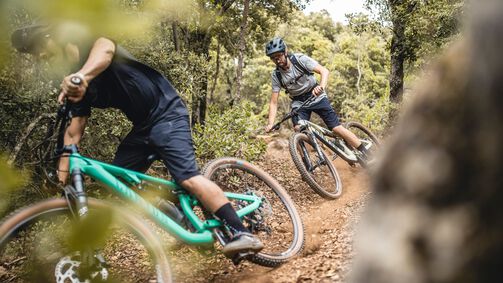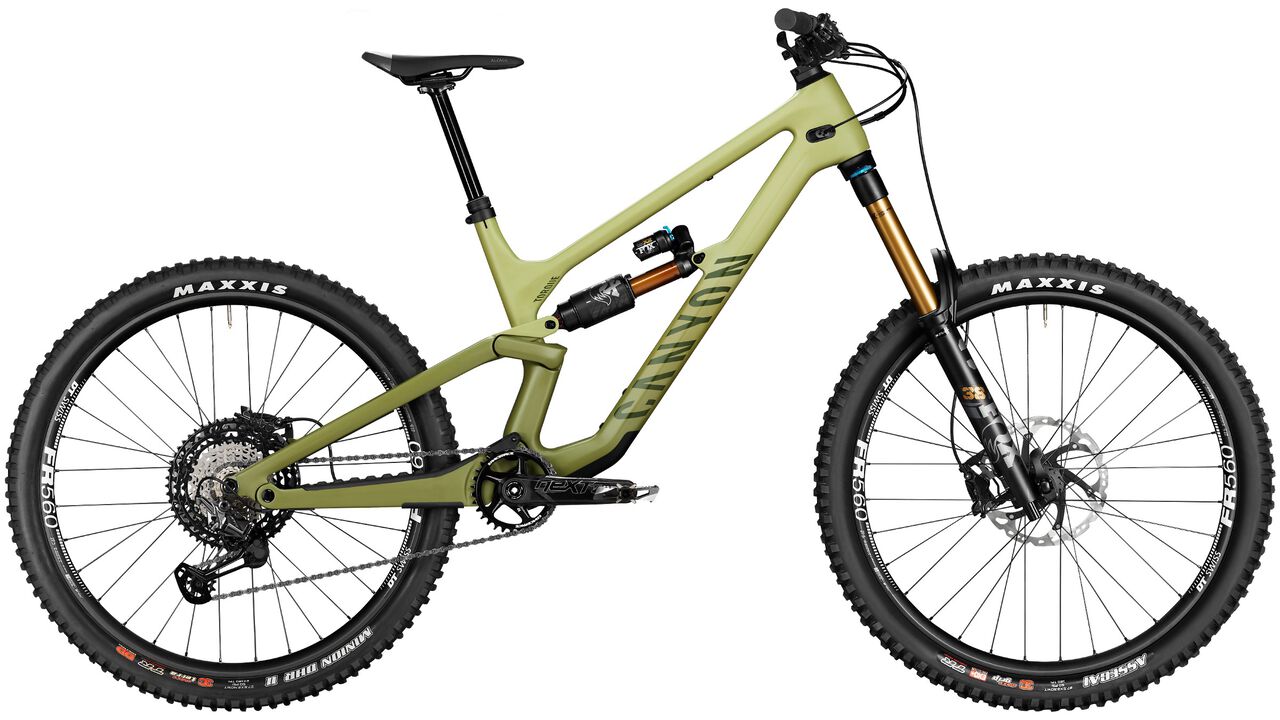Carbon or aluminium: Which is the best frame material for a mountain bike?
Carbon or aluminium mountain bike? Unpick the hype to find the right frame for you.


One of the first questions many people ask when they are looking for a mountain bike frame is: carbon or aluminium? The question of whether you want to ride a carbon or aluminium-framed mountain bike can be a tough one. Are you paying for hype and snake oil with carbon fibre? Are you missing out on much if you take budget-friendly aluminium?
Here at Canyon, we love both carbon and aluminium bikes and have many years of experience working with both materials. This short guide will take you through some of the background to this debate, debunk some of the myths and hopefully help you figure out which one is right for you.
Contents
A brief history of MTB frame materials
When the first mountain bike pioneers pushed their bikes up to the top of Mount Tam in California in the 1970s, they all rode steel-framed bikes. Back then it was the only choice, especially for the garage scientists and mad welders who led the vanguard of the young sport.
Once the sport began to grow and commercialise, aluminium came to the fore. Lighter, easier to work with than steel and, with production in China and Taiwan, cheaper too. It set the imprint for light, affordable mountain bikes and steel was consigned to the margins of the sport.
In the 1990s a new, space-age material began to appear on downhill race bikes - carbon fibre. While this new wonder material seemed to have endless potential for creating complex shapes and tuning the ride feel, the reality was that it took a long time to understand how to make a good mountain bike out of carbon fibre. It is only in the last decade or so that carbon has come to dominate the high ends of the mountain bike market.
Aluminium has not rested dormant either, and modern aluminium mountain bikes are a long way from the early, straight-tubed examples. A modern trail bike like the Spectral Al uses advanced production techniques, like hydroforming, to create more complex shapes with the metal and we believe it matches its carbon counterpart for feel on the trail.
Why are carbon fibre frames more expensive?
It is much harder to produce a frame from carbon than aluminium. Each frame is made up of what is called a layup. The layup is formed from dozens of small strips of carbon impregnated with glue that have to be laid over each other to form the desired shape of the bike on a mould. This task is too complicated to be done by a machine and has to be done by hand with exacting precision - one piece even slightly out of place could ruin a frame.
The two halves of the mould are then joined together around a bladder that will keep the layup in place. This is all then put in an oven to be cooked. The glue in the carbon strips liquifies and bonds all the strips together. When it is cooled, the moulds and the bladder are removed and you are left with a bicycle frame.
All these precise steps mean that it takes a lot more time and attention to create a carbon mountain bike frame, making them more expensive. This also means specific material and layup patterns can be selected, tuned and shaped with far more precision than is possible with aluminium, offering the possibility of exciting design options and refinements in ride feel.

Canyon mountain bikes
- Swipe left and right to compare the Torque 29 AL 6 and the Torque 27.5 CF 9
- Available in different versions.
Why do aluminium frames have fewer features than carbon frames?
Because carbon can be made into such complicated shapes, it is easier to include new features, like frame storage, in a carbon frame. For example, the carbon Spectral features a downtube storage compartment, while the aluminium version does not. It would be possible to include a compartment on the aluminium version, but there are two barriers. Because of the nature of aluminium, it would take a lot more extra material to add the storage compartment and it would take a lot of extra work to produce a frame. This means the bike would need to be heavier and more expensive.
Because the aluminium versions are designed to be more budget-friendly, we felt that most riders would prefer a simpler, lighter aluminium frame at a lower price.
Which is more durable, carbon or aluminium?
This is a more complex question than some people would have you believe. You may have been told that carbon fibre is inherently fragile - this is not true in a modern mountain bike. Our ASTM category 5-rated Sender downhill race bike is made from carbon and has been proven time and again at the highest level of competition in mountain biking’s most extreme discipline.
That said, if you do damage the carbon layup on your frame in a crash then the chances are that you will need a new frame. With an aluminium frame, it may survive such an impact with nothing more than a dent.
Do I need to check my carbon or aluminium frame for cracks?
There is a lot of advice out there about checking carbon frames for cracks, but the truth is that every frame material can suffer issues. When you wash your bike it is worth checking it over thoroughly for damage or anything unusual. If you have a crash it is even more important that you closely check your frame for damage before the next ride.
With an aluminium bike, this would mainly be looking for dents and cracks at the welds. With a carbon bike, the damage can be less obvious, which is why there is so much written about it. You will need to look for any evidence of cracking or damage to the layup. Although the damage may seem small at first, there is a chance that if you continue riding a damaged frame it could fail. If you are not sure what you have found, it is always best to check with our service team who will be able to help you assess the problem.
What about aluminium fatigue?
All metals have a fatigue life, if they are stressed repeatedly then over time they will begin to break. This may sound scary, but the truth is that most riders never keep their bikes long enough to experience these kinds of issues. If you are planning on keeping your bike for a couple of decades, we would recommend getting a carbon frame as it does not experience fatigue in the same way, but for most people, it is not something they need to worry about.
Carbon or aluminium for a beginner mountain biker?
If you are just starting your mountain bike journey, we would say that budget is more important than anything else. You can get lost in the depths of the great carbon vs aluminium debate or the hardtail vs full suspension debate, but we think you’d be better off buying the bike you can afford now and getting out riding. This is why we do not offer a carbon fibre version of our Grand Canyon hardtail. Designed as an affordable, fun all-round bike that would be perfect for a beginner, it packs everything you need to get started inside its sturdy aluminium frame.
If you would like more help choosing a beginner’s mountain bike, we have created a guide to our range to walk you through it.
Carbon or aluminium for a cross-country racer?
In a sport where bike weight is crucial, we believe there is only one material choice for a cross-country bike: carbon fibre. That is why we offer both the Lux and the Exceed only in carbon-framed options. The frame of the feather-light Lux World Cup weighs just 1,535g and this would not be possible with aluminium. If you are on a tighter budget, we think a model like the Exceed 5 carbon hardtail is a great choice, offering the same high-end frame as our top models, but with more affordable components.
Carbon or aluminium for downhill?
If you are looking to go between the tapes and do some racing, you are going to want a downhill race bike like the Sender. We think that for the rigours of World Cup racing at the highest level, carbon is the natural choice for such a high-performance bike. If this does not sound like you and your idea of downhill riding is at a more leisurely pace, we would recommend looking at the Torque. Available in both carbon and aluminium options, an entry-level model like the aluminium-framed Torque 5 offers all the fun of high-octane riding in a more affordable and easier-to-ride package.
Carbon or aluminium for enduro?
Because enduro is a racing discipline, we think carbon is the best material for an enduro competition bike. This is why we make the Strive race bike only in carbon fibre. If you are on a tighter budget and would like to try your hand at enduro racing, we think a bike like the Spectral 5 would be a great option as an all-round bike that would be more than capable in an enduro race.
Carbon or aluminium for trail riding?
This is where the question gets harder, because fun is the only thing that matters so there is no clear answer here. This is why we make the Spectral in both carbon and aluminium - to let you decide which suits you best. Both versions share the same geometry, kinematic and ride feel. This means that both should be a lot of fun for you and the decision will come down to weighing your other priorities.

Advantage and disadvantages of carbon vs aluminium
Here’s a quick round-up of the pros and cons of carbon and aluminium mountain bike frames.
| Aluminium | Carbon | ||
|---|---|---|---|
| Pro | Con | Pro | Con |
| Affordability | Weight | Light weight | Price |
| Simplicity | Lack of frame features | Frame features | Risk of crash damage |
| More resistant to crashing | Looks |
There is no right or wrong answer if you are having fun riding your bike. You can weigh all the factors, scrutinise all the numbers and consult all the experts, but it all comes down to how the bike makes you feel. If you want an aluminium bike just because you think it looks a bit cooler, then we think that is the perfect answer. If you want a carbon because that is the red one? Great. As we said at the start, getting out riding is more important than what bike you do it on.
Which one is right for me?
If you have read this far and are still unsure which bike you need, then we have written several guides that can help you. There is our mountain bike finder tool, that asks a few questions about your riding preferences and recommends a bike for you. We have our mountain bike buyers’ guide that walks you all the way through our range. Then we have our bike comparison tool that can help you compare models head-to-head.
If you are still not sure about all this, we’d recommend heading to one of our experience centres. The friendly team there will be able to talk you through the models we offer and would be happy to set you up with your own little carbon vs aluminium test.
Discover our Mountain Bikes
Did this article help?
Thank you for your feedback
-
 About the author
About the authorMatt Wragg
Get to know Matt Wragg, the freelance photographer, writer, and self-proclaimed bicycle-breaker based in Nice, France. Despite unsuccessful attempts at XC, trials, 4X, and DH racing, Matt's passion for mountain biking never waned. After a stint in communications consulting, he decided to pursue his love for cycling and moved to New Zealand. Since then, he has traveled the world, chasing trails and building a successful career as a cycling photographer and writer. In 2021, he was diagnosed as autistic and has been coming to terms with it. His bike cellar is a true testament to his love for cycling, housing bikes that range from freeride to cargo.

















